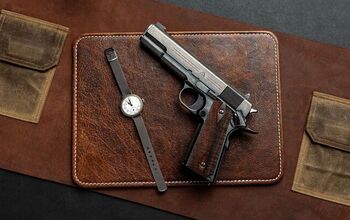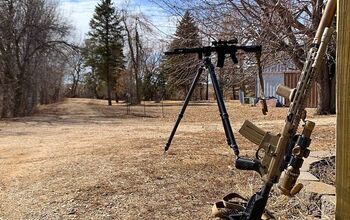The GM-94 Launcher: From Anti-Terror Operations To Avalanche Control

In this article, we’ll discuss the history and design of the Russian GM-94 repeating hand-held grenade launcher. This pump-action launcher was designed by the KBP Instrument Design Bureau in Tula, which received a request from the Ministry of Internal Affairs for a grenade launcher designed for urban operations. They developed a multi-shot launcher that utilizes the newly designed VGM93 43x30mm grenades. These grenades are engineered to minimize blast effects in confined urban environments, reducing the risk of collateral damage to the operator and their team.
The goal was to create a more accurate grenade launcher than the existing RG-6, identified by its GRAU designation 6G30. A reduced capacity was acceptable if the new grenade launcher offered improved precision.
The primary concern is the grenade itself; the traditional VOG-25 grenade does not meet operational requirements. The new design aims to reduce the fragmentation radius from 20 meters to below 10 meters. To achieve this, a thin plastic casing was used for the grenade, allowing for a limited lethal radius that can be as small as 3 meters, depending on the specific VGM93 grenade. This capability enables the operator to fire the weapon safely at near point-blank ranges.
History
The design of the GM-94 is based on the RMB-93 Lynx shotgun. The layout of the design was to use a movable barrel and a stationary tubular magazine tube. The concept was first introduced in 1993, called the GM-93, but only in 1997 did it gain interest from the Russian army.
GM-94 was submitted to government testing in 2001, and in 2002, the Russian Federation Ministry of Defense adopted the GM-94, designated as LPO-97 ‘light infantry flamethrower’ and the thermobaric grenade ammunition. The LPO-97 was adopted for the RF chemical troops RHBZ/RChBD. The LPO-97 is classified as a flamethrower, which the Russian army considers most hand-held thermobaric weapons to be ‘flame weapons,’ even though they are thermobaric munitions. Thermobaric munitions are not defined as incendiary weapons; they rely on a chemical reaction to generate a blast wave to generate negative pressure as the explosion consumes atmospheric oxygen. This extraordinary pressure can collapse structures and organs. Shortly after adopting the LPO-97, it was used by the FSB at the 2004 Beslan school siege.
In 2003, KBP initiated a research and development project for the Ministry of Internal Affairs. This project resulted in modifications to the weapon system to meet the customer's specifications. After these adjustments, the GM-94 was officially adopted in 2005 by the Ministry of Internal Affairs after the Russian Federation authorized the weapon system and grenades to be used by internal affairs agencies. The adoption was followed by the Federal Security Service (FSB) in 2008, the Federal Protection Service (FSO) in 2011, and the Russian National Guard in 2017, underscoring the widespread acceptance and use of the GM-94 in various security and defense agencies. In 2013, the GM-94 was used for avalanche control per RD 52.37.790-2013. This was first tested in 2009 as a portable means of avalanche control.
Design
The GM-94 was designed as a multi-shot launcher, and the pump-action design was chosen for its reliability and ease of use, similar to the US China Lake multi-shot pump-action grenade launcher used during the Vietnam War with the US Navy Seals.
The GM-94, based on the RMB-93 Lynx shotgun, is a pump-action, magazine-fed weapon that uses an integrated tubular magazine located above the rifled barrel. The magazine holds three rounds and can be reloaded through a top-opening loading door above the receiver, allowing the operator to have three rounds plus one in the chamber. Fired cartridge cases are ejected downwards, enabling the GM-94 to be fired from either shoulder. The GM-94 trigger is a double action only with an internal hammer, providing a reliable and consistent firing mechanism. An ambidextrous manual safety is above the pistol grip for ease of use. The folding stock folds on top of the receiver and acts as a carrying handle when folded, providing a compact and portable design. The GM-94 and the LP0-97 have minor differences, and the rear sight can make the visual identification; the PLO-97 and early GM-94s use a flip sight for different ranges, and the current production GM-94s use a ladder sight from 50 to 300 meters. The GM-94 ladder sight has changed from a rounded loop to a rectangular rear ladder sight.
Specs:
- Caliber 43x30mm
- Weight 10.6 lbs. (4.8kg)
- Capacity shots: 3 +1 in the chamber
- Muzzle velocity 280fps (85m/s)
- Effective range of 300 meters
- Maximum range 800 meters
The VGM93 43x30 grenade currently offers 11 types of fillers to address various requirements. The most common are the VGM93.900 high explosive fragmentation grenade and the VGM93.100 thermobaric. Non-lethal grenades include the VGM93.300 smoke, VGM93.200 tear gas, and VGM93.600 rubber slug. Depending on the charge, the grenade's radius can be up to 3 meters, and the minimum safe shooting distance is only 5 meters.
The latest development of the M32A1 allows it to use the new 40x51mm medium-velocity ammunition, extending its range to 800 meters. The GM-94 could serve as a comparable alternative, with a range of 800 meters, already exceeding the traditional Russian GP series, which has a range of 400 meters. One GM-94 per squad would significantly increase the unit's firepower. Introducing a multi-shot grenade launcher concept into Russian infantry squads could provide advantages similar to the USMC M32A1.

Lynndon Schooler is an open-source weapons intelligence professional with a background as an infantryman in the US Army. His experience includes working as a gunsmith and production manager in firearm manufacturing, as well as serving as an armorer, consultant, and instructor in nonstandard weapons. His articles have been published in Small Arms Review and the Small Arms Defence Journal. https://www.instagram.com/lynndons
More by Lynndon Schooler














![[SHOT 2025] Glock Debuts Aimpoint Combo Pistols, New Pistol Light](https://cdn-fastly.thefirearmblog.com/media/2025/01/22/00501/shot-2025-glock-debuts-aimpoint-combo-pistols-new-pistol-light.jpg?size=350x220)
![[SHOT 2025] Real Avid Displays New X3 Driver Kits](https://cdn-fastly.thefirearmblog.com/media/2025/01/28/00015/shot-2025-real-avid-displays-new-x3-driver-kits.jpg?size=350x220)












Comments
Join the conversation
Really cool looking but I hear lots of people complaining that personal grenade launchers aren’t lethal enough and that they hardly ever cause death in combat. Is this true? I dunno.
A lethal range of 3 meters and a safe minimum of 5 makes it sound like its basically a really large firework being shot off, not even HE. I suppose that may be useful still, even if it doesn't kill I imagine its quite loud and concussive so it may double as a sort of flash bang.